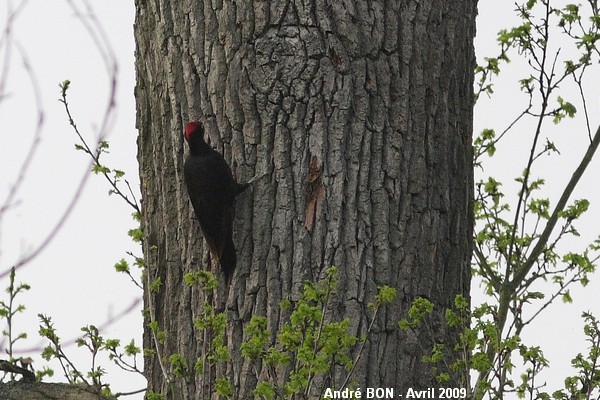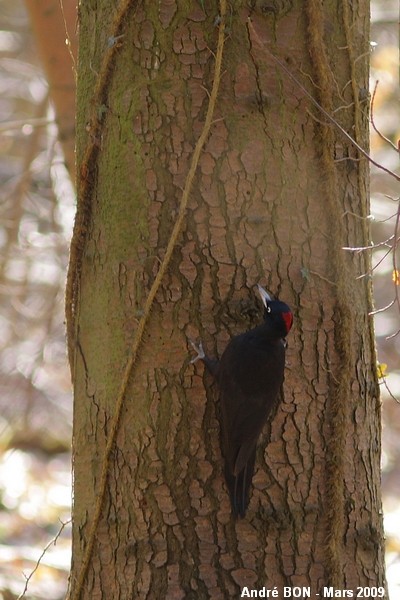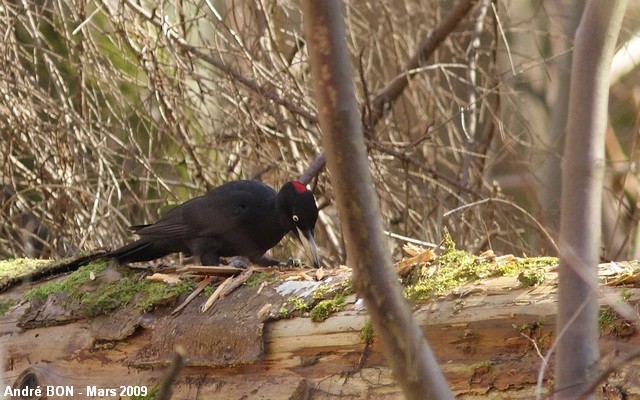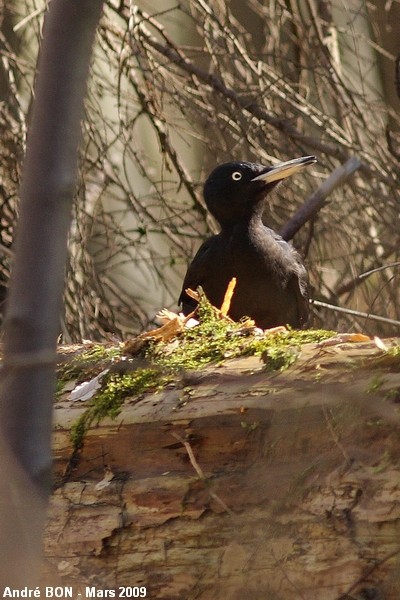





| Black Woodpecker (Dryocopus martius (Linnaeus, 1758)) |






|
|
Scientific name: Dryocopus martius (Linnaeus, 1758) Common name: Black Woodpecker French name: Pic noir Order: Piciformes Family: Picidae Size: Body size : 46 cm; Wingspan : 65 cm; Weight : 300 to 350 g Habitat: Coniferous or deciduous forests with sparse high trees. Food: The Black Woodpecker is mainly insectivorous. It feeds on xylophagous insects, ants and larvae picked by digging into dead or dying trees. It may occasionally feed on fruits and berries too. Nesting: Black Woodpeckers form pairs in January with a nuptial display. The nest, made by the male, is large hole dug in the trunk of a high tree. It is between 4 and 15 meters high. The opening is usually large and oval-shaped. Females lay 3 to 5 eggs in April. Migration: Sedentary. Young Black Woodpecker will spread out since their first flight and can settle more that ten kilometres away from their birth place. Geographic area: Europe, Northern Asia, Siberia east to Japan. |
The Black Woodpecker is a large black bird showing a bright red crown. The entire crown is red on males and only the top hind crown is red on females. The bill is strong and pale grey. The tongue is long and sticky, it has very small hooks on the tip. The fingers have strong curved claws used to hook on tree bark. Two fingers stand forwards while two fingers stand backwards. The Black Woodpecker moves along trunks using its stiff tail as a support. Unlike other Woodpeckers, the Black Woodpecker has a rather straight flight. It often emits a sharp call in flight. It has a nice song and its drumming is the longest among Woodpeckers, it can last up to 3.5 seconds. |
| [To know more about the Black Woodpecker] [Next picture] [Top] |

|
Some time ago, I have noticed a hole looking like a Black Woodpecker hole, high in this oak tree. I came back here this time because I have heard its song. The entire red crown indicates a male. I have seen it moving along the trunk and along the other trees around, but it never came close to the hole. It is because of my presence? |
| [To know more about the Black Woodpecker] [Next picture] [Previous picture] [Top] |

|
Here is the typical behaviour of the Black Woodpecker, looking for food by hammering into trunks with its strong beak. |
| [To know more about the Black Woodpecker] [Next picture] [Previous picture] [Top] |

|
A black bird crossed the forest path with a straight flight in just ahead of our group of runners. I had no doubt when I heard its sharp flight call. This is not a Carrion Crow but a Black Woodpecker. I came back to this place the day after. I have not seen the Black Woodpecker but many dead trees (certainly since the huge tempest of 1999) showing the marks of attacks by its strong beak (I have identified theses marks immediately because I had just read the excellent issue of the "journal de la Hulotte" describing this beautiful bird). On my second visit, my attention has been attracted by a noise of low frequency beak hits. I have been able to shoot my first series of Black Woodpecker pictures by walking towards these sounds. |
| [To know more about the Black Woodpecker] [Next picture] [Previous picture] [Top] |

|
The red crown, reduced to the rear part of the head, indicates a female. I have done this first observation with the sun in front of me. This is not easy to set the right exposure parameters. |
| [To know more about the Black Woodpecker] [Next picture] [Previous picture] [Top] |

|
The Woodpecker flew away when I approached, and it landed a few meters from there where I had noticed many lying trunks with beak marks. I tried to approach a second times and I have been able to observe it during a few minutes taking the trunk to pieces. |
| [To know more about the Black Woodpecker] [Previous picture] [Top] |

|
The Black Woodpecker detected my presence when I tried to get closer. here is one of the last pictures of the series. I have not performed any other observations though I came back several times to this area. |